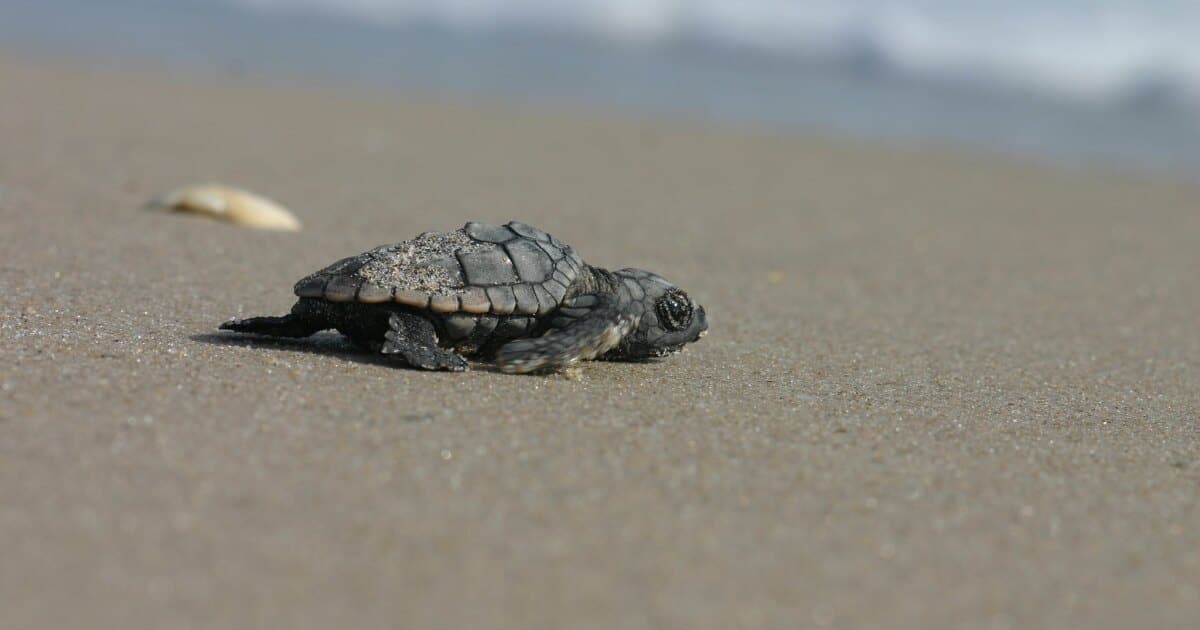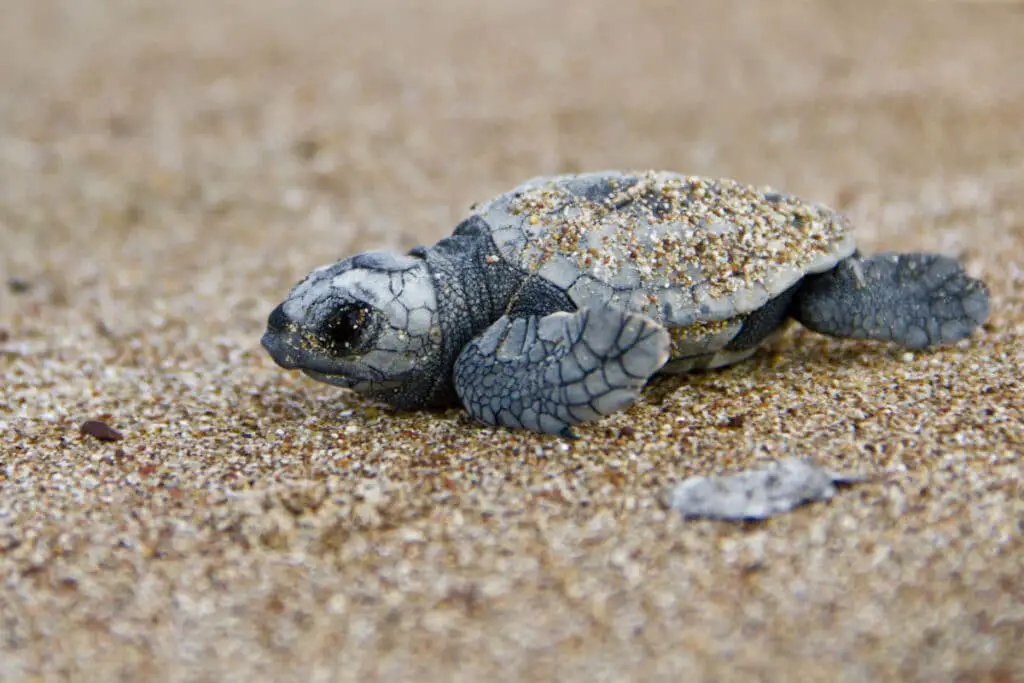Can Sea Turtles Hide In Their Shells

Introduction
Can Sea Turtles Hide In Their Shells: The world’s oceans are home to a diverse array of fascinating creatures, and among them, sea turtles stand out as iconic and enigmatic beings. These ancient reptiles have roamed the oceans for millions of years, surviving the test of time and adapting to various environmental challenges. While their impressive shells have long been associated with protection, the question of whether sea turtles can truly hide within these shells remains a subject of curiosity and scientific inquiry.
Sea turtles possess unique anatomy, with a bony carapace covering their backs and a plastron on their underside. These shells serve as critical components of their skeletal structure, offering protection against predators and environmental hazards. However, unlike some land-dwelling turtles, sea turtles cannot retreat entirely into their shells. This fundamental distinction has sparked debates and inquiries among marine biologists and naturalists, prompting them to delve deeper into the mysteries of sea turtle physiology.
Join us as we investigate whether these ancient mariners can indeed hide within their shells or if their defense mechanisms rely on a different set of adaptations. In doing so, we aim to shed light on one of the ocean’s most captivating mysteries and gain a deeper appreciation for these remarkable creatures that have navigated our seas for countless millennia.

Why can’t sea turtles hide in their shells?
Sea turtles have the same muscles as other turtles, which allows them to pull back their heads, but there is simply not enough space in the shell to fully retract the head. Sea turtles have a flatter shell than tortoises and have no space to retract their head into their shell.
Sea turtles, unlike their terrestrial relatives, cannot retract into their shells due to differences in their anatomy and lifestyle. Their shells, composed of bony plates covered by a layer of keratin, are adapted to the specific demands of their aquatic environment. Unlike the hinged shells of some land turtles, sea turtle shells are fused to their vertebrae, providing vital support for swimming. This adaptation allows them to navigate the open ocean with grace and agility.
The inability to fully retract into their shells also relates to the unique challenges sea turtles face in their underwater world. In the vast ocean, their main threats are large predators like sharks and, historically, other marine reptiles. Instead of retreating into their shells, sea turtles have evolved to rely on their speed and agility to escape danger. Some species, like the leatherback turtle, even have softer, more flexible shells that enhance their swimming efficiency.
Additionally, sea turtles employ camouflage and seek refuge in coral reefs or underwater crevices as part of their defense strategy. These behavioral adaptations, combined with their streamlined shells, offer them the best chances of survival in their oceanic habitat. So, while sea turtles cannot hide in their shells as land turtles can, they have evolved a unique set of features and behaviors to thrive in the challenging marine environment they call home.
Why is my turtle hiding in its shell?
When danger strikes, turtles use their flexible necks to retract their heads safely inside their shield-like shells. Evolutionary researchers have long assumed that turtles developed this trick as protection against predators, but new research suggests that its original purpose was likely not defense, but food.
When your turtle retreats into its shell, it’s typically a natural behavior rooted in self-defense or a response to environmental stressors. Turtles, both aquatic and terrestrial, have evolved this protective mechanism over millions of years.
- Self-Defense: The most common reason for a turtle hiding in its shell is to protect itself from perceived threats. When it senses danger or feels vulnerable, a turtle will retract its limbs and head into its shell, using the shell’s hard exterior as a shield against potential predators. This instinctual response is crucial for their survival in the wild.
- Stress and Anxiety: Turtles can also withdraw into their shells when they are stressed or anxious. Changes in their environment, such as sudden loud noises, unfamiliar people or animals, or disruptions to their habitat, can trigger this response. In captivity, stress can be caused by inadequate living conditions, improper handling, or illness.
- Illness or Injury: When a turtle is unwell or injured, it might retreat into its shell as a way to cope with discomfort or pain. This behavior can be an indicator that something is amiss with your turtle’s health, and it’s essential to monitor it closely and seek veterinary care if necessary.
What turtles can’t hide in their shells?
A snapping turtle can’t hide in its shell.
A snapping turtle’s plastron — the lower shell — is only big enough to barely cover the body. It can retreat slightly underneath the carapace — the upper shell — but not anywhere near how a typical turtle can.
Turtles are renowned for their protective shells, but it’s essential to recognize that not all turtle species can hide completely within their shells. While many terrestrial and freshwater turtles can retract their limbs and head entirely, some cannot due to unique adaptations that suit their specific lifestyles.
- Snapping Turtles: Snapping turtles, known for their powerful jaws and aggressive behavior, are a prime example. Their shells are not designed for complete concealment. Instead, they rely on their formidable bite and defensive posturing as their primary means of protection.
- Softshell Turtles: Softshell turtles, as the name suggests, have relatively soft shells compared to their hard-shelled counterparts. These aquatic turtles have flexible, leathery shells that provide protection but are not suitable for full retraction. Their streamlined bodies and swift swimming abilities are their primary defense mechanisms.
- Sea Turtles: Sea turtles, adapted for life in the ocean, have shells that are fused to their vertebrae and cannot be pulled into their body like those of land turtles. They depend on their swimming prowess and the vastness of the ocean to evade predators.
These turtles have evolved alternative strategies for defense and survival, such as rapid swimming, burrowing in sediment, or camouflaging in their surroundings. While they lack the ability to hide entirely within their shells, they have honed other skills to navigate their respective environments effectively. Understanding these adaptations is crucial for appreciating the diversity of turtle species and their remarkable abilities to thrive in their chosen habitats.
What are 3 interesting facts about sea turtles?
10 Tremendous Turtle Facts
- Green sea turtles are what they eat!
- Sea turtles lay their eggs in a nest they dig in the sand with their rear flippers.
- Sand temperature is very important.
- Hawksbill turtles use their beaks to help extract their favorite prey.
- One sea turtle species nests during the day.
Sea turtles are fascinating creatures that have captured the imagination of people around the world. Here are three interesting facts about these remarkable reptiles:
Ancient Travelers: Sea turtles are ancient mariners, with a history dating back more than 100 million years. They are believed to have shared the planet with dinosaurs. These resilient creatures have survived through countless environmental changes and have adapted to various oceanic ecosystems.
Unique Navigation Skills: Sea turtles possess an incredible ability to navigate across vast ocean expanses. They use Earth’s magnetic field and cues from the Earth’s surface to find their way, even during long migrations. This remarkable navigation system helps them return to the exact beaches where they were born to lay their eggs.
Long Lifespans and Slow Growth: Sea turtles exhibit a slow and steady approach to life. They have impressively long lifespans, with some species living up to 80 years or more. Their growth rate is also gradual, and it can take several decades for them to reach maturity. This slow pace of life adds to their mystique and underscores the importance of protecting their habitats to ensure their survival.
These three facts showcase the resilience, navigation prowess, and unique life history of sea turtles, making them one of the most captivating creatures of the ocean.
Are turtles safe in their shell?
A turtle’s shell is its armor and its ultimate protection from many of the dangers of the world. But when that strong shell is cracked or broken, it leaves the turtle vulnerable to infection, bacteria, and predation by other animals. Though turtles are resilient, a severe injury to the shell could cost its life.
Turtles are renowned for their distinctive protective shells, which serve as both a physical fortress and a sanctuary. While their shells provide a remarkable degree of safety, it’s essential to understand the limitations of this defense mechanism.
Turtle shells are composed of two main parts, the upper carapace and the lower plastron, which are fused to the turtle’s spine and ribcage. These shells are incredibly tough and can withstand a variety of threats. They act as a shield against predators, helping turtles evade attacks from creatures like raccoons, birds, and some larger fish.
However, the shell isn’t an impenetrable fortress. Some predators, such as alligators and certain species of snakes, possess the strength and specialized adaptations to crack open a turtle’s shell. Additionally, human activities, like habitat destruction and vehicle collisions, pose significant risks to turtles. While their shells offer protection against natural threats, they cannot safeguard them from all the dangers they face in the modern world.
A turtle’s shell provides a level of safety, but it is not foolproof. Turtles have evolved to rely on their shells as a primary means of defense, but they still require our help and conservation efforts to ensure their survival in an increasingly challenging environment.
What is the purpose of a sea turtle’s shell if it doesn’t provide the same protection as a land turtle’s shell?
A sea turtle’s shell, while similar in structure to that of a land turtle, serves a somewhat different purpose due to the distinct environments these two types of turtles inhabit.
Firstly, a sea turtle’s shell is adapted for buoyancy and streamlined swimming rather than solely for protection. Sea turtles spend the majority of their lives in water, where they face fewer natural land-based predators like raccoons or birds. While their shells are not as hard or impenetrable as those of some land turtles, they are still effective at providing some protection against potential threats in their aquatic environment.
Secondly, sea turtles have evolved a suite of survival strategies that complement their shells’ limitations. They rely on their speed and agility to evade predators in the water. Additionally, their ability to retreat their limbs and head into their shells, though not to the same extent as land turtles, can offer some defense when necessary.
Ultimately, the primary purpose of a sea turtle’s shell is to provide structural support, aid buoyancy, and offer some protection against potential threats while allowing for efficient swimming. Their survival in the ocean depends on a combination of their shells, physical adaptations, and behaviors adapted to their underwater world, rather than relying solely on the robust protection that land turtles’ shells offer in terrestrial environments.
How do sea turtles protect themselves from predators if they can’t hide in their shells?
Sea turtles have developed various strategies to protect themselves from predators in their oceanic environment, despite not having the same shell-hiding capability as land turtles. Here are some of the ways they safeguard themselves:
Speed and Agility: Sea turtles are remarkably fast swimmers, capable of reaching speeds of up to 20-25 miles per hour. They use their strong, flipper-like limbs to dart away from potential threats, making it challenging for predators to catch them.
Camouflage: Many sea turtle species have evolved coloration and patterns that provide camouflage in their natural habitat. This helps them blend into their surroundings, making it difficult for predators to spot them from a distance.
Depth and Diving: Sea turtles can dive to significant depths and hold their breath for extended periods, which allows them to escape predators by submerging themselves beyond the reach of many threats. Some species can dive several hundred feet deep.
Swallowing Stones: Some sea turtles, such as green sea turtles, are known to ingest small stones or pebbles, which may help them weigh down and maintain buoyancy, making it challenging for predators to flip them over or keep them at the water’s surface.
Protective Group Behavior: Some species, like the loggerhead turtle, engage in group migrations known as “rafting” during their early life stages. Traveling in groups can provide protection through numbers, as predators are less likely to single out an individual in a group.
While sea turtles lack the protective shell of land turtles, their adaptations, speed, and behavior have evolved to help them survive in their oceanic environment and minimize the threats posed by various predators.
Are there any species of turtles that can hide in their shells among sea turtles?
Among sea turtles, there are no species that can retract their limbs and head fully into their shells as land turtles can. This is a fundamental difference between sea turtles and their terrestrial counterparts. Sea turtles’ shells, while serving important functions related to buoyancy and protection, do not provide the same level of concealment as the shells of land turtles.
Sea turtles have adapted to their oceanic environment, where the need for streamlined bodies for efficient swimming takes precedence over the ability to retract into a protective shell. Instead, sea turtles have evolved other defense mechanisms, such as speed, agility, camouflage, and the ability to dive to avoid predators.
In contrast, land turtles have developed the ability to retract into their shells, which serves as a primary means of defense against predators in their terrestrial habitats. The retractable head and limbs of land turtles allow them to retreat into the safety of their protective shells, making it difficult for predators to harm them.
While sea turtles are fascinating and well-adapted to their oceanic lives, their shells primarily serve purposes other than providing concealment and protection in the same way as land turtles’ shells do.

Conclusion
Through our exploration, we’ve uncovered that while sea turtles possess impressive shells, these structures are not designed for complete concealment like those of some land-dwelling turtles. Instead, sea turtles rely on a combination of physical adaptations and behavioral strategies to defend themselves in the vast oceanic realm.
Their shells provide valuable protection against certain threats, such as shark bites, and serve as a critical element of their skeletal structure. However, the inability to retract fully into their shells has led sea turtles to develop alternative defense mechanisms. These include their remarkable swimming capabilities, camouflage, and the art of seeking refuge in coral reefs and underwater crevices.
Our journey into the world of sea turtles has not only answered the question at hand but has also highlighted the importance of preserving their habitats and safeguarding their populations. Sea turtles face numerous challenges, from plastic pollution to habitat destruction, and our understanding of their unique adaptations can inform conservation efforts.
As we continue to explore the mysteries of the natural world, let us remember the remarkable sea turtles and the lessons they teach us about resilience, adaptation, and the delicate balance of life in our oceans. Through research, education, and collective action, we can ensure that these ancient mariners continue to grace our seas for generations to come.



